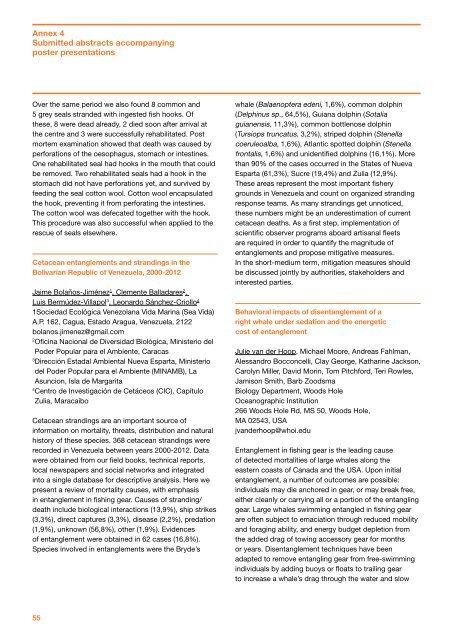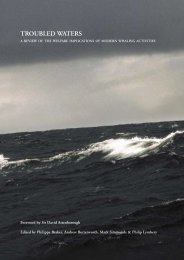Proceedings of the Untangled symposium: - WSPA
Proceedings of the Untangled symposium: - WSPA
Proceedings of the Untangled symposium: - WSPA
Create successful ePaper yourself
Turn your PDF publications into a flip-book with our unique Google optimized e-Paper software.
Annex 4Submitted abstracts accompanyingposter presentationsOver <strong>the</strong> same period we also found 8 common and5 grey seals stranded with ingested fish hooks. Of<strong>the</strong>se, 8 were dead already, 2 died soon after arrival at<strong>the</strong> centre and 3 were successfully rehabilitated. Postmortem examination showed that death was caused byperforations <strong>of</strong> <strong>the</strong> oesophagus, stomach or intestines.One rehabilitated seal had hooks in <strong>the</strong> mouth that couldbe removed. Two rehabilitated seals had a hook in <strong>the</strong>stomach did not have perforations yet, and survived byfeeding <strong>the</strong> seal cotton wool. Cotton wool encapsulated<strong>the</strong> hook, preventing it from perforating <strong>the</strong> intestines.The cotton wool was defecated toge<strong>the</strong>r with <strong>the</strong> hook.This procedure was also successful when applied to <strong>the</strong>rescue <strong>of</strong> seals elsewhere.Cetacean entanglements and strandings in <strong>the</strong>Bolivarian Republic <strong>of</strong> Venezuela, 2000-2012Jaime Bolaños-Jiménez 1 , Clemente Balladares 2 ,Luis Bermúdez-Villapol 3 , Leonardo Sánchez-Criollo 41Sociedad Ecológica Venezolana Vida Marina (Sea Vida)A.P. 162, Cagua, Estado Aragua, Venezuela, 2122bolanos.jimenez@gmail.com2Oficina Nacional de Diversidad Biológica, Ministerio delPoder Popular para el Ambiente, Caracas3Dirección Estadal Ambiental Nueva Esparta, Ministeriodel Poder Popular para el Ambiente (MINAMB), LaAsuncion, Isla de Margarita4Centro de Investigación de Cetáceos (CIC), CapítuloZulia, MaracaiboCetacean strandings are an important source <strong>of</strong>information on mortality, threats, distribution and naturalhistory <strong>of</strong> <strong>the</strong>se species. 368 cetacean strandings wererecorded in Venezuela between years 2000-2012. Datawere obtained from our field books, technical reports,local newspapers and social networks and integratedinto a single database for descriptive analysis. Here wepresent a review <strong>of</strong> mortality causes, with emphasisin entanglement in fishing gear. Causes <strong>of</strong> stranding/death include biological interactions (13,9%), ship strikes(3,3%), direct captures (3,3%), disease (2,2%), predation(1,9%), unknown (56,8%), o<strong>the</strong>r (1,9%). Evidences<strong>of</strong> entanglement were obtained in 62 cases (16,8%).Species involved in entanglements were <strong>the</strong> Bryde’swhale (Balaenoptera edeni, 1,6%), common dolphin(Delphinus sp., 64,5%), Guiana dolphin (Sotaliaguianensis, 11,3%), common bottlenose dolphin(Tursiops truncatus, 3,2%), striped dolphin (Stenellacoeruleoalba, 1,6%), Atlantic spotted dolphin (Stenellafrontalis, 1,6%) and unidentified dolphins (16,1%). Morethan 90% <strong>of</strong> <strong>the</strong> cases occurred in <strong>the</strong> States <strong>of</strong> NuevaEsparta (61,3%), Sucre (19,4%) and Zulia (12,9%).These areas represent <strong>the</strong> most important fisherygrounds in Venezuela and count on organized strandingresponse teams. As many strandings get unnoticed,<strong>the</strong>se numbers might be an underestimation <strong>of</strong> currentcetacean deaths. As a first step, implementation <strong>of</strong>scientific observer programs aboard artisanal fleetsare required in order to quantify <strong>the</strong> magnitude <strong>of</strong>entanglements and propose mitigative measures.In <strong>the</strong> short-medium term, mitigation measures shouldbe discussed jointly by authorities, stakeholders andinterested parties.Behavioral impacts <strong>of</strong> disentanglement <strong>of</strong> aright whale under sedation and <strong>the</strong> energeticcost <strong>of</strong> entanglementJulie van der Hoop, Michael Moore, Andreas Fahlman,Alessandro Bocconcelli, Clay George, Katharine Jackson,Carolyn Miller, David Morin, Tom Pitchford, Teri Rowles,Jamison Smith, Barb ZoodsmaBiology Department, Woods HoleOceanographic Institution266 Woods Hole Rd, MS 50, Woods Hole,MA 02543, USAjvanderhoop@whoi.eduEntanglement in fishing gear is <strong>the</strong> leading cause<strong>of</strong> detected mortalities <strong>of</strong> large whales along <strong>the</strong>eastern coasts <strong>of</strong> Canada and <strong>the</strong> USA. Upon initialentanglement, a number <strong>of</strong> outcomes are possible:individuals may die anchored in gear, or may break free,ei<strong>the</strong>r cleanly or carrying all or a portion <strong>of</strong> <strong>the</strong> entanglinggear. Large whales swimming entangled in fishing gearare <strong>of</strong>ten subject to emaciation through reduced mobilityand foraging ability, and energy budget depletion from<strong>the</strong> added drag <strong>of</strong> towing accessory gear for monthsor years. Disentanglement techniques have beenadapted to remove entangling gear from free-swimmingindividuals by adding buoys or floats to trailing gearto increase a whale’s drag through <strong>the</strong> water and slow55
















